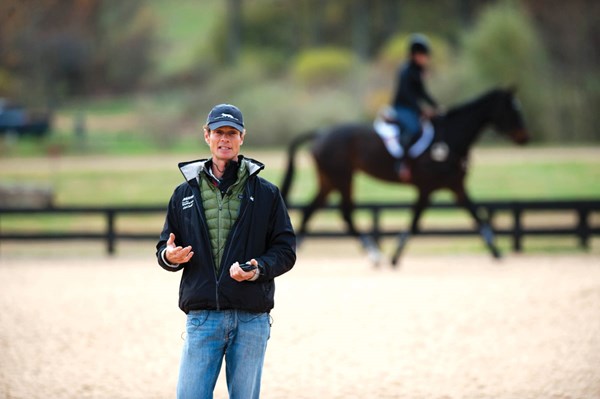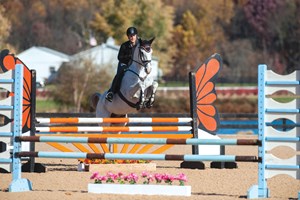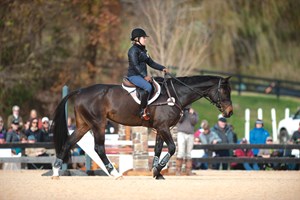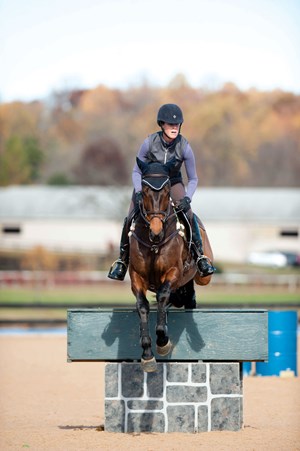
-Warm up your horse with a plan and the goal of making him relaxed, focused and ready to do the hard work.
-Concentrate on your position at all times.
-Train your horse so he is self-reliant and attentive both on the flat and over fences.
These were three main themes that eventing superstar and Great Britain’s Olympic silver medalist William Fox-Pitt repeated throughout a two-day clinic he gave in early November at Morningside Training Center in The Plains, Virginia. More than 200 auditors and 15 riders, ranging from Training to Advanced level, benefited from the clinic organized by Kelly Gage of Team EnGaged Clinics. The first day focused on flatwork and the second day on jumping.

“What I enjoyed most about the clinic was the ability to see inside the mindset of one of the greatest of all time,” said rider Allison Springer about the multiple CCI**** winner. “He has a kind and thoughtful demeanor that you can tell he brings to every aspect of training his horses and is why he performs so consistently in competition.”
Day 1: Warm-Up
Displaying his trademark calm and centered demeanor, William started the first day of the clinic reminding everyone that the warm-up is the most important part of any horse’s routine. He stressed that horses are roamers with large muscles who require a long warm-up period before being asked to work.
As the riders went to work in a large outdoor arena, William first simply observed. He then asked some riders to describe the intent of their warm-up. Often it was unclear. Riders need to create a structure in the warm-up, he said, and include moving their horses forward and asking them to come back as well as doing bending and softening work. He told several riders to canter sooner, while staying off their horses’ backs. This loosened up the horses’ muscles, encouraging them to engage their hind legs and soften more quickly throughout their whole bodies.

As the horses warmed up, they displayed a wide variety of types. Several started out tense, lazy or not very stretchy. William told the riders to use transitions within and between the gaits to help the tense horses relax and the lazy ones to be sharper. For those who found it hard to stretch, William had clinic participants ride their horses more up to the bridle. He wanted the horses to stretch in a manner that showed they were relaxed. The result was horses more responsive and tuned in to their riders’ aids. Only after the horses were relaxed and focused did William have the riders start to build their horses’ outlines so they were round but loose and supple. American riders have a bad habit of framing the horse so tightly that they lose the suppleness in his back.
One of the most difficult warm-up exercises for horses and riders was riding from free walk to medium walk to free walk. As riders struggled, William had several of them hold both reins in their outside hands. The horses responded by taking more contact on the outside reins, allowing for better inside-leg to outsiderein connections. “Using the reins in one hand keeps us realizing we use too much inside rein. And it keeps us from overbending our horses,” he explained later during the question-and-answer session. Afterward, Victoria Jessop, who rode her Desert Mystery in the Intermediate-level group, said, “My horse was very tense, and William’s advice helped in getting him through the back. Riding with one hand really helped my inside-rein to outside-leg connection.”

For a few horses who still were having difficulties, William suggested the riders change rein more often and start riding some simple leg-yields. He also encouraged riders to be brave in the walk as a way to encourage the horse to show more flow and reach in the exercise. With his help, every horse showed improved connection that continued over to the trot, canter and lateral work.
As the warm-up progressed, William reminded riders to assess their positions by looking at anatomical alignments. For flatwork, he said, the shoulder, hip and heel need to be in one line. He asked several riders to open their hip angles while loosening their shoulders. This helped the horses relax and show better quality and evenness in their steps. Then he had them use an inside opening rein to encourage more flexibility in both themselves and their horses. William asked other riders to loosen their shoulders by simply moving them around as they rode, saying “still shoulders equal stiff shoulders equal stiff hands.” During this work, he told a few of the riders that the hands should be forward, holding the contact, not grabbing backward for it. The work improved rider contact, which also encouraged many of the horses to have better quality and evenness in their steps.
As riders incorporated spiraling-in and -out circles into the warm-up, William told them to focus on making the steps relaxed and regular but powerful. The same applied during leg-yield work, during which he also reminded riders to make the steps the same size regardless of the direction of travel.
For the warm-up canter work, William offered two useful tools for horses who had less flexibility and flow. The first was to have the riders canter with their leg on (as in normal riding) for one canter stride and then off for one stride. To make this clear he told them to say “canter [leg on] and [leg off] canter [leg on] and [leg off] … .” The whole leg should relax, but only the lower leg will look as if it is off the horse, he explained later. This encouraged the horses to rely on themselves for balance and open up their strides. The second tool was for riders to canter over four poles on the quarters of a 20-meter circle. As the horses worked over the poles, they became more flexible and adjustable, which helped them come into better balance and rely less on their riders. To help a few horses who tended to fall over their shoulders in the canter work, William had their riders canter from a large circle to a small circle and back to a large circle. As the horses returned again to the small circle, the riders asked for a transition to walk. The horses were then asked to canter again after a few steps of walk and the exercise was repeated. After two or three repetitions, the horses became much more balanced.
Day 1: Dressage
As the riders finished the warm-up phase and moved to the dressage ring located within the large arena, several horses began to get tense again and others became spooky. William had these riders leave the arena and return while still in warm-up mode. He urged them never to punish a spooky horse but instead to slow down while continuing to work to give the horse time to think and let him face his fears, and then get on with the work.
Once the horses had settled into the more structured dressage work, William began addressing individual movements. In the leg-yield, he told riders to make sure their shoulders and their horses’ chests were parallel to the end of the arena. In shoulder-in, their shoulders should be at the same angle as their horses’ shoulders. In travers, their seats should give enough to allow their horses’ haunches to travel smoothly to the inside. William then worked to help riders put the movements together at the various gaits. He emphasized that they need to learn to plan the changes from movement to movement.
This lesson led to a discussion about the importance of the dressage phase in modern eventing. William said he thinks that riders should shoot for a “clear round” in the dressage phase as they do in the jumping phases: Riders should strive to score 7s on each movement and aim higher. Consistent 7s with a few 8s and 9s lead to very good overall scores.
Day 2: Jumping
As the second day got underway, the warm-up again was of great importance, as was a self-reliant horse. “The horse must be able to fend for himself,” William said, stressing that it is not realistic to have all the fences on any jumping course perfect. Horses need to be forward, focused and able to jump when things are a little wrong or a lot wrong. “A horse that can fend for himself is a safe horse,” he said.

Throughout the day, William commented on tack-related issues. Many riders came in with their breastplates too tight. “Your breastplate should be there in case your saddle starts to slide. It shouldn’t be there to keep your saddle in place,” he said. A too-tight breastplate can act as a chest brace, causing fatigue. Additionally, a few horses came in with elevator or gag bits. “Maybe you need that for competition, but I doubt you need it for what we are doing today,” he said. He also talked about neck straps. He uses one with every horse he rides and on every ride. Riders can use it to stay out of the mouths of young horses when they overreact, he said, and they can use it to keep going with older horses if things go wrong.
In the jumping warm-up, it was clear that most of the riders had thought about the lessons of the previous day. When a few still struggled with finding connection, William had them continue their warm-up one-handed. He insisted that the contact be the same quality as it had been during the dressage training.
As the warm-up progressed, William had the riders find their own ways over the small crossrails and brush boxes in the arena. After watching them, he began to have them jump over small obstacles from walk. Most of the horses were unsure about this. Some balked, some overjumped and some tried to run out. William told the riders to be patient and wait for their horses. This exercise made all of the horses sharper and more focused, and it drove home the need for the riders to wait. When the horse makes a mistake at walk or trot, as opposed to the canter, he has more time to digest and understand what he did wrong.
Next William had the riders trot over the small brush boxes, crossrails and finally, through a jumping grid of barrels and skinny boxes that bent to an arrowhead fence. Just as with the walk–jump exercise, he wanted the riders to wait for the jumps and to react to what happened. He also stressed the need for better position with every rider. Some rode with too-long stirrups, causing their knees to be straight and their positions to be stiffer. For jumping, he said, riders should sit more over their heels, so their shoulders and knees are aligned as well as their hips and heels. It is impossible to do this when stirrups are too long. When the rider shortens the stirrups and rides more dynamically, it is less fatiguing to the horse as he travels around the course. William suggested riders raise their stirrups after their flatwork warm-up. They also may need to shorten their stirrups again before riding cross country. He warned them to adjust the stirrups before starting the cross-country round in competition. Riders often get over the first fence before they realize their stirrups are too long or too short. By then it is too late. Fix them before you go.

As riders continued over the fences, William noted that some got a little too forward. He had them wait with their bodies while coming to the jumps and then react to what happened. He also addressed riders using their upper bodies to try to jump when the striding was off. He told them to use their legs, not their upper bodies, to go forward as they approached the fences. Others relied on their spurs to create a forward horse. William said the horse should know that the leg, not the spur, means go. He suggested these riders take off the spurs for a while at home and use a dressage whip in conjunction with the leg to retune their horses to the “go” leg.
By the end of the two days, everyone, from riders to horses to auditors, benefited from William’s help. “I asked him tons of questions,” said Allison Springer, who recently organized a syndicate to purchase William’s 2012 Olympic partner Lionheart. “… He was more than happy to discuss anything, from bitting to conditioning and all the training and competition fun in between. He definitely helped me to think about a few things in a new light.”
“The clinic was wonderful,” agreed Sharon White, who rode Under Suspection in the Advanced-level group. “William nailed how to put the movements together. He is very much a horseman. Riding with William reminded me to be a good horseman.”
William Fox-Pitt Born in 1969 and having ridden from a young age, William Fox-Pitt started eventing at age 15. Both of his parents completed Badminton and Burghley three-day events, and he completed Badminton himself at the age of 20. Five years later, he won his first Burghley, which helped earn him a spot on the British team for the1996 Atlanta Olympics.
In 2002, William was the first British rider to become eventing’s Number 1 rider on the FEI rankings list. (He was also ranked Number 1 in 2009 and 2010.) He represented Great Britain at the 2004 Athens Olympics, where he helped the team earn a silver medal. He was a member of the 2008 Olympic team that brought home bronze from Hong Kong, and more recently, he was on the silvermedal- winning eventing team at the 2012 London Olympics. In addition, he earned team bronze at the 2002 World Equestrian Games in Jerez, team silver at the 2006 WEG in Aachen and team gold and individual silver at the 2010 WEG in Kentucky. He also has won seven team gold medals at the European Championships.
William is the only rider to have won five of the world’s six CCI****s, having won Burghley six times, Badminton in 2004, Luhmuhlen in 2008, Rolex Kentucky in 2010 and 2012 and Pau in 2011. He has won the HSBC FEI Classics, a series linking the top six three-day events in the world, three times (in 2008, 2010 and 2012) and finished second in 2011. His most recent success was winning individual bronze at the 2013 European Championships.
He and his wife, British television racing presenter Alice Plunkett, own and operate their 28-stall stable, Wood Lane Stables in Dorset, England. They live there with their three children and an assortment of animals.
This article originally appeared in the February 2014 issue of Practical Horseman.

